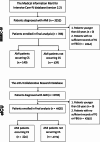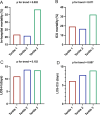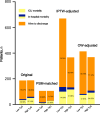Triglyceride-glucose index correlates with the occurrence and prognosis of acute myocardial infarction complicated by cardiogenic shock: data from two large cohorts
- PMID: 39261816
- PMCID: PMC11391630
- DOI: 10.1186/s12933-024-02423-8
Triglyceride-glucose index correlates with the occurrence and prognosis of acute myocardial infarction complicated by cardiogenic shock: data from two large cohorts
Abstract
Background: Triglyceride-glucose (TyG) index, a dependable indicator of insulin resistance, has been identified as a valid marker regarding multiple cardiovascular diseases. Nevertheless, the correlation of TyG index with acute myocardial infarction complicated by cardiogenic shock (AMICS) remains uncertain. Our study aims for elucidating this relationship by comprehensively analyzing two large-scale cohorts.
Methods: Utilizing records from the eICU Collaborative Research Database and the Medical Information Mart for Intensive Care IV, the link between TyG and the incidence and prognosis of AMICS was assessed multicentrally and retrospectively by logistic and correlation models, as well as restricted cubic spline (RCS). Propensity score matching (PSM), inverse probability of treatment weighting (IPTW), and overlap weighting (OW) were employed to balance the potential confounders. Subgroup analyses were performed according to potential modifiers.
Results: Overall, 5208 AMI patients, consisting of 375 developing CS were finally included. The TyG index exhibited an apparently higher level in AMI populations developing CS than in those who did not experienced CS [9.2 (8.8-9.7) vs. 9.0 (8.5-9.5)], with a moderate discrimination ability to recognize AMICS from the general AMI (AUC: 0.604). Logistic analyses showed that the TyG index was significantly correlated with in-hospital and ICU mortality. RCS analysis demonstrated a linear link between elevated TyG and increased risks regarding in-hospital and ICU mortality in the AMICS population. An increased mortality risk remains evident in PSM-, OW- and IPTW-adjusted populations with higher TyG index who have undergone CS. Correlation analyses demonstrated an apparent link between TyG index and APS score. Subgroup analyses presented a stable link between elevated TyG and mortality particularly in older age, females, those who are overweight or hypertensive, as well as those without diabetes.
Conclusions: Elevated TyG index was related to the incidence of CS following AMI and higher mortality risks in the population with AMICS. Our findings pointed a previously undisclosed role of TyG index in regard to AMICS that still requires further validation.
Keywords: Acute myocardial infarction; Cardiogenic shock; Insulin resistance; Triglyceride-glucose index.
© 2024. The Author(s).
Conflict of interest statement
The authors declare no competing interests.
Figures






References
Publication types
MeSH terms
Substances
Grants and funding
- 2022QNRC001/Young Elite Scientists Sponsorship Program by CAST
- 82200433/National Natural Science Foundation of China
- QML20230602/Beijing Hospitals Authority Youth Programme
- 2021YFC2701700 and 2021YFC2701703/National Key Research and Development Program of China
- ZYLX202111/Beijing Hospitals Authority Clinical Medicine Development of Special Funding Support
LinkOut - more resources
Full Text Sources
Medical
Miscellaneous

